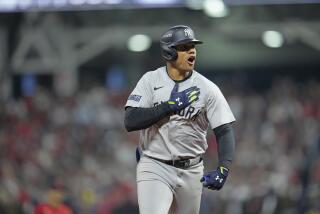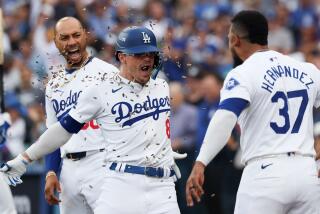There’s Potential, but Many Problems Exist
Perhaps the most distinguishing characteristic of the New York Yankee teams that have won four of the last six World Series is that their whole has been greater than the sum of their parts.
Only twice since 1996 has a Yankee hit more than 30 home runs in a season, and only three times has a Yankee stole more than 30 bases. There have been only three 20-game winners in the Yankee rotation in six years, and of the six Gold Glove awards, only two were won by someone other than center fielder Bernie Williams.
But the Yankees combined high on-base ability at the top of the order, clutch hitting in the middle and solid contributions at the bottom, smart, aggressive base-running, consistent starting pitching, superb late-game relief and dependable defense to forge another baseball dynasty.
The Dodgers, on the other hand, appear to be the un-Yanks. There are some attractive individual pieces and the potential for some unknown pieces to emerge, but uncertainty surrounds so many key components, they don’t seem to fit together very well.
Add it up, and the Dodgers, who open the 2002 season Tuesday at home against San Francisco, will be hard-pressed to end their 13-year drought without a playoff victory.
Unless their ace, Kevin Brown, a right-hander with one of the game’s nastiest repertoires, and right-hander Andy Ashby, whose 2001 season lasted only two starts, recover fully from elbow surgery and give the Dodgers 30-plus starts each.
And their Japanese left-hander, Kazuhisa Ishii, suppresses the jitters that hindered him in spring training, finds a consistent rhythm to his delivery and controls his arsenal of pitches.
And their young left-hander, Odalis Perez, proves the Dodgers made a wise choice in picking him over Omar Daal for the rotation by pitching deep into games and giving his team a chance to win on a regular basis.
And their converted starter, Eric Gagne, who has a 97-mph fastball, an excellent curve and an improving changeup but only 10 career relief appearances, quickly develops the mentality required to close games and gives the Dodgers a reliable ninth-inning hammer.
And their right fielder, Shawn Green, who had a career year with Gary Sheffield next to him in the lineup in 2001, sees enough quality pitches to approach his production of a .297 batting average, 49 home runs, and 125 runs batted in from last season.
And their corner infielders, first baseman Eric Karros and third baseman Adrian Beltre, rebound from awful, injury-plagued seasons and team with new left fielder Brian Jordan to provide clutch hits and lineup protection for Green.
And their catcher, Paul Lo Duca, proves his breakthrough season in 2001, when he hit a team-high .320 with 25 home runs, 28 doubles, 90 RBIs, a .374 on-base percentage and a .379 mark with runners in scoring position, was no fluke.
And their 22-year-old shortstop, Cesar Izturis, the Dodgers’ sixth opening-day shortstop in six years, lives up to his spring-training accolades by providing quality defense and some energy, speed and a run-producing boost to the second spot in the order.
And their new leadoff batter, center fielder Dave Roberts, sets the table far better than the Dodgers did in 2001, when their leadoff batters combined for a .306 on-base percentage, second-worst in the league.
Get the picture? A lot has to go right for the Dodgers, who finished six games behind Arizona despite a dizzying array of injuries last season, to compete for the National League West championship. Yet, there is the potential for so much to go wrong.
“We have the capabilities of being a very productive offensive club if everyone does what they’ve done historically,” Karros said. “Nobody has to be great. But we can’t have three guys be bad. I don’t even know if we can have two guys be bad.”
It seems risky for a team with a $102-million payroll that fancies itself a playoff contender to have such inexperience in the middle of the field, at the top of the lineup and in the closer role.
But the Dodgers didn’t have a choice. An inflexible roster filled with bloated, impossible-to-trade contracts tied General Manager Dan Evans’ hands, forcing him to make patchwork, mostly low-budget changes.
Their goal, though, was to become more athletic and less lethargic, to construct an offense based on speed more than power, one that could put more pressure on the defense, and to rely on those old staples, pitching and defense.
Roberts and Izturis may not be the second coming of former St. Louis Cardinal sparkplugs Vince Coleman and Willie McGee, but they have the potential to be more productive than the top of the 2001 Dodger lineup. If they get on base, Jim Tracy can manage more aggressively.
“Will this lineup play itself out? I don’t know, but it has some of the ingredients that were not there in a pennant race a year ago,” Tracy said.
“We didn’t hit enough at the bottom of the order, and we didn’t get on base enough at the top. If our pitchers do what their resumes dictate, we won’t have to score six runs a game.”
The Dodgers have been a station-to-station team for several years, but hitting Coach Jack Clark, who played with Coleman and McGee on those great Cardinal teams of the 1980s, thinks they can wreak havoc on the basepaths in 2002.
“When you peck away, when you can score runs without getting hits, it just kills [opponents],” Clark said. “If you do that early in the game, you can demoralize a team. They’re like, ‘God, we didn’t give up any hits, and they’ve already scored.’
“That’s how the Cardinals were. Guys got on base, the catcher had to call more fastballs, the pitchers had to slide-step, and that took more focus away from the hitter.
“The defense is forced to make plays. It benefits you in a lot of little ways.”
All spring, Tracy stressed the importance of going from first to third on singles, of taking a base on a pitch in the dirt or when an outfielder overthrows a cut-off man, of getting runners home from third with less than two outs, of being patient at the plate.
Of course, Tracy stressed the same things last season, and the Dodgers scored fewer runs (758 to 798), had fewer walks (519 to 668), a lower on-base percentage (.323 to .341) and fewer sacrifice hits (57 to 66) than they did in 2000.
More to Read
Are you a true-blue fan?
Get our Dodgers Dugout newsletter for insights, news and much more.
You may occasionally receive promotional content from the Los Angeles Times.










